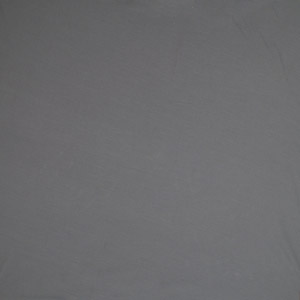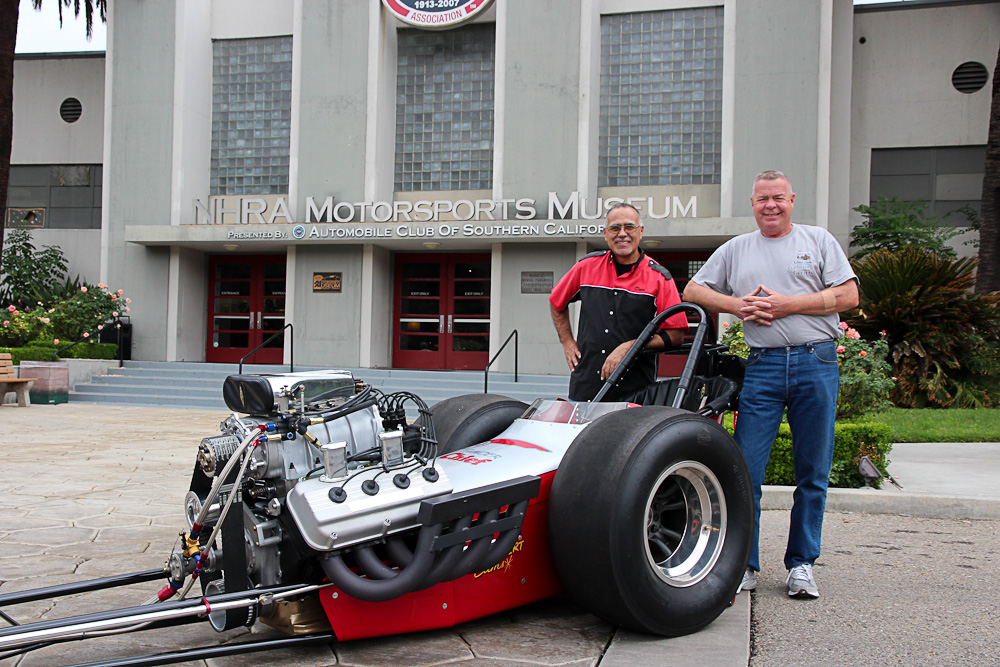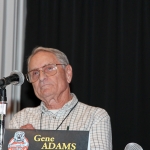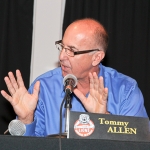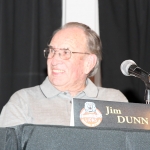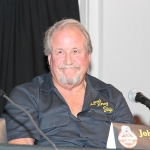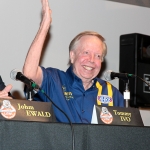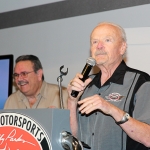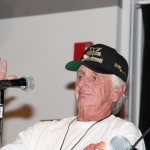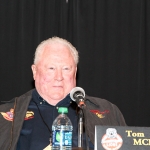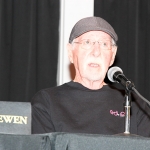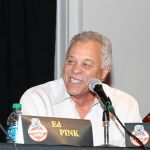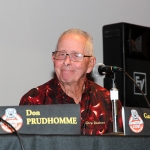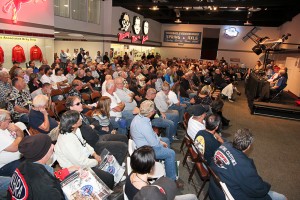40TH ANNIVERSARY OF THE LAST DRAG RACE AT LIONS, December 1, 2012, NHRA Museum, Pomona, CA
It was a damp, dreary, dark, chilly day: December 2, 1972, the last drag race at Lions Drag Strip, Long Beach, CA.
It was a damp, dreary, dark, chilly day: December 1, 2012, the 40th anniversary of the last drag race at Lions Drag Strip, NHRA Museum, Pomona, CA.
Once again many of drag racing’s legends gathered at the NHRA Museum in Pomona, CA to reminisce about the magic that was Lions Drag Strip and to remember the last Lions drag race held 40 years ago. Last year 177 people attended the event. This year 350 chairs were set up and the crowd spilled out into the hallway. Two panel discussions were capably led by Greg Sharp, Curator of the Museum, and Dave McClelland, the “Voice of the NHRA”.
The first panel:
Gene Adams – Engine builder Gene Adams worked for Hilborn for years and now runs Gene Adams Performance.
Don Gillespie – Don Gillespie is a photojournalist who has made DVD’s and written about Lions.
Bones Balogh – Bones Balogh is one of the more notable gasser builders and drivers. Among the cars he drove was Big John Mazmanian’s ’41 Willys.
Jim Dunn – Jim Dunn’s first car was a flat head Lincoln- powered Volkswagen. His 40 year career includes winning 3 March Meets.
John Ewald – John Ewald was the track photographer at Lions for 5 years under “Pappy” Hart. With his brother Don Ewald, he runs the drag racing historical site “We did it for Love”.
Tommy Ivo – Tommy Ivo was the 2012 CHRR Grand Marshal. Because of his TV and movie career, he is known as “TV Tommy”. Ivo’s twin engine Buick was the first to go 160, 170 and 180 mph. Ivo is one of the top fuel pioneers and is credited with the first 5 second run.
The first question posed to the panel by Greg Sharp was “What made Lions magic”? The responses varied: Gillespie said the tamales with chili, and the place was like family. Ewald offered the air and track prep which gave great traction. Adams said it was easy to get to – everybody was there and the good track prep. Ivo said it was a back alley place; he could drive his Model T to the track, run throughout the day and then drive it home again. Dunn stated because so many cars ran, there was a lot of rubber on the track. Balogh believed it was the good air and that it was home track to so many racers; he took his ’55 Olds, knocked off the hubcabs and ran.
Lions offered a place for a variety of cars to run – cars ran the gamut from “run what you brung” to top fuel. When Pappy Hart was running Lions he started the Jr. Fuel class and the ET brackets in order to provide racing opportunities to more people. Racing was different then. The cars left the line at about 3 minute intervals. When a car dumped oil onto the track, the track crew would throw down some oil absorbent, run a broom through it and send the stockers down the track. Lions also allowed the fans to get up close to the cars. A chain link fence separated the fans from the track. As Gary Cochran noted: “Lions was a happening not a drag race – it was where everybody was.”
Between the two panel discussions, previews of the new movie “Snake and Mongoose” were shown. The movie is scheduled to be out next summer and looks to be good. In the movie, the Snake once again takes the wheel of the iconic Greer, Black and Prudhomme car.
The second panel:
Mike Kuhl – Mike Kuhl is the owner/ builder of the Kuhl and Olsen top fuel car. Kuhl and Olsen won top fuel at the last Lions drag race and many other events for years afterwards. Kuhl now restores vintage race cars;
Roland Leong – Roland Leong is “the Hawaiian” and raced under that name for decades. He had a driving career that lasted 7 seconds. After he crashed his top fuel car, he decided driving wasn’t for him and hired Don Prudhomme to drive his car. Over 4 decades, Leong had 22 different drivers.
Tom McEwen, “the Mongoose” – The idea for the Lions reunions came from Tom McEwen. McEwen made more runs in more cars at Lions than anyone else and from Lions he went on to a 40 year career in racing. McEwen was the ultimate promoter and secured sponsorship from Mattel for the Snake and Mongoose rivalry. The Mongoose beat the Snake at Lions last drag race.
Ed Pink – Ed Pink has been building race engines since the early 60’s. Both Prudhomme and McEwen raced with Pink engines. Ed Pink Racing Engines is still building engines in the shop it started in Van Nuys in 1965.
Don Prudhomme “the Snake” – Don Prudhomme had a 47 year drag racing career, 32 years behind the wheel and 15 years as an owner. The Snake and Mongoose rivalry changed drag racing forever. Don Prudehomme is No. 3 on the NHRA list of top 50 drivers.
Gary Cochran – Gary Cochran started racing in 1964 in a Ford powered modified roadster. Gary Cochran built, owned and tuned his own cars until 1970, when he switched to just driving. He drove many cars including Bob Melville’s funny car.
When asked “what made Lions magic?” this panel answered: Kuhl said it was a good track at sea level. McEwen said everyone could work up with different partners to learn and improve. Prudhomme said it was like playing “Yankee Standium” it was the coolest place ever. Pink liked the good air and smooth track which let him build engines with as much power as possible, he just had to get the clutch, tire and gear ratio right. Cochrane noted that when the fog came in you had to drive to half – track to see the finish line but Lions was where everybody was.
In talking about the last race at Lions, Kuhl described the chaos during the last race – the final round of top fuel. Kuhl and Olson met Jeb Allen at the line for the last race. Kuhl and Olson took the win giving Allen the distinction of being the last car down the track at the last Lions drag race. Throughout the day the crowd had been out of control – wandering onto the track, pulling down signs and prying up boards from the bleachers. Kuhl said they were concerned about running and considered waiting until Sunday to run the final race. In the end they decided to run on Saturday. As Allen and Olson sat at the line, fans were actually unbolting the guard rails. Olson ran over a couple of beer bottles on his run down the track. After the race was over it took more than an hour to get the car back from the finish line.
Other panel members shared their stories and told their tales. Seems that stories varied depending on who was telling it. Like the story told by McEwen about when he was driving for Lou Baney. Baney had been running a Pink built Chrysler Hemi when he switched to a Ford engine. McEwen didn’t like the performance of the Ford engine and says Baney fired him. Pink then recommended Baney hire Prudhomme. Baney agreed and Pink called Prudhomme telling him McEwen had quit. Prudhomme replaced McEwen driving for Baney. The banter that followed between McEwen and Prudhomme with Pink in the middle had the standing room only crowd laughing.
Around the room were mementos from Lions Drag Strip including Rick Voegelin’s very impressive working scale model of Lions Drag Strip. Before the start of the panel discussions, Rick allowed participants to run scale model cars down the strip with time and speed indicated on the score board.
In the end, Lions fell victim to the same fate as have many other drag strips since – neighbors complaining about the noise. Lions operated between 1955 and 1972 and is considered to be the greatest drag strip ever!
[pydsmugmugslider albumid=”26874053″ albumkey=”5bFgNK” albumtype=”slider” imagesize=”OriginalURL” imagelink=”LightboxURL” ]
